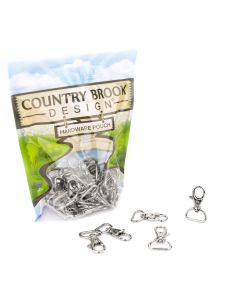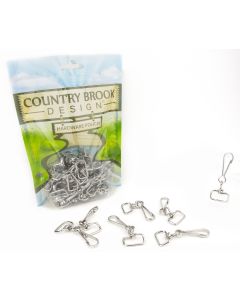Snap Hooks

Snap hooks, also known as spring hooks, are versatile hardware components widely used in various industries for securing, connecting, and fastening. These compact, durable tools have a spring-loaded mechanism that allows for quick and secure attachment to a variety of objects, making them indispensable in activities like climbing, sailing, construction, and even pet care.
Construction
Snap hooks are typically made from sturdy materials such as stainless steel, aluminum, or brass to ensure strength, durability, and resistance to corrosion. Their design features a looped body with a spring-loaded gate that can open and close under pressure. This gate mechanism ensures a secure hold once attached while enabling easy disengagement when needed. Variations in construction include:
- Bolt: Often referred to simply as a bolt snap, it is a specific type of snap hook with a spring-loaded sliding mechanism resembling a bolt action. They are prized for their reliability and ease of use.
- Lever: Utilizes a lever mechanism for secure and quick attachment. This type of snap hook is widely used in applications requiring frequent and secure connections.
- Trigger: Called a trigger snap or trigger clip, this uses a spring-loaded trigger mechanism for secure and effortless attachment.
- Gooseneck: Named for its elongated, curved shape resembling a goose's neck, this snap hook is built to handle high loads while providing secure and efficient fastening.
- Bull: Commonly known as a bull snap or bull hook, is a heavy-duty fastening device designed for strength and durability.
- HK Sling: A compact, tactical-style snap hook designed for secure connections in rugged and high-performance environments. Originally developed for military and law enforcement use, the HK snap hook takes its name from its association with Heckler & Koch (HK) firearms, as it was often used for weapon slings.
Snap hooks come in various sizes and shapes, such as D-shaped, oval, or pear-shaped, each tailored for specific applications.




Uses
The adaptability of snap hooks makes them essential in countless scenarios, including:
- Outdoor and Recreational Activities: Utilized in climbing, camping, and other outdoor gear that requires secure and robust connections.
- Marine and Boating: Commonly used in rigging, mooring lines, and anchor systems due to their ability to handle high loads and resist corrosion in harsh, wet environments.
- Equestrian Gear: Found in horse tack, such as halters and lead ropes, where durability and ease of use are essential.
- Industrial Applications: Workers in construction and maintenance rely on snap hooks to attach tools, harnesses, and safety lines.
- Everyday Convenience: Pet owners use snap hooks in leashes, while campers find them handy for securing gear.
- Fashion and Accessories: They often appear in handbags, belts, and jewelry as a stylish yet functional component.
- Everyday Carry (EDC): Used to secure keychains, lanyards, or small tools for convenient access.
- Tactical and Military Applications: Frequently used to attach weapon slings to firearms, pouches, or vests, providing secure and quick-access connections in dynamic environments.
History
The origin of snap hooks traces back to the late 19th century, evolving from basic hooks and clasps. Early designs were rudimentary but laid the foundation for the modern snap hook's development. By the mid-20th century, innovations in metallurgy and engineering allowed for the creation of lightweight, high-strength designs, cementing their role in specialized activities like mountaineering and aerospace.
Snap hooks remain a symbol of efficiency and reliability, combining simplicity with ingenuity. Their enduring presence across diverse industries underscores their importance in connecting people, tools, and safety systems in an ever-evolving world.
 Review and Win! Share your verified review and get a chance to win a $25 store credit!
Review and Win! Share your verified review and get a chance to win a $25 store credit! 










